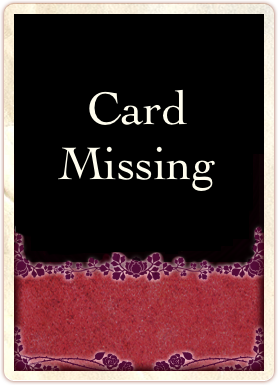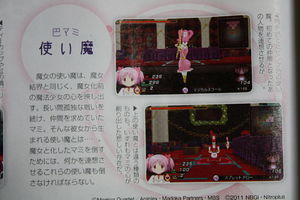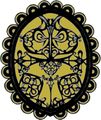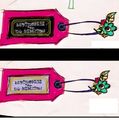Candeloro
Candeloro (CANDELORO) is the witch form of Mami Tomoe that makes an appearance in Puella Magi Madoka Magica Portable. Like the anime, her design was done by Gekidan Inu Curry. She has two familiars that represent Madoka Kaname and Kyoko Sakura, in both appearance and fighting style.
おめかしの魔女。その性質はご招待。理想を夢見る心優しき魔女。寂しがり屋のこの魔女は結界へ来たお客さまを決して逃がさない。
|
The witch of dress-up. She has an inviting nature. A kind-hearted witch who dreams of ideal things. This witch can't stand being lonely, and never lets visitors to her barrier escape. | ||||||||||
Minions
The dress-up witch's minions, whose task is to guide visitors. They invite humans who enter the witch's barrier to her tea party. When they try to run away from her, the witch ties their hands and feet together. They are precious friends of the witch. | |||||||||
Translations
From the January 2012 Dengeki PlayStation
Trivia
- Candeloro is an Inu Curry creation.
- Candeloro's barrier include familiar elements of Mami's "mental landscape" including a rainbow bridge, teacups and apple trees.
- Candeloro's familiars take the forms of Madoka Kaname and Kyoko Sakura. The familiars fight in the same fashion as the magical girls. The one that resembles Madoka shoots arrows from a pink bow while the one that resembles Kyoko uses a long-range multiple spear attack.
- Candeloro attacks resembles Mami's. She has a simple rifle-like attack and can bind using ribbons. She can also take possession of a familiar to shoot a Tiro Finale-like attack, except it shoots flames rather than ammunition.
- Text in her barrier reads "Happy Birthday."
- How Mami becomes Candeloro is described in her game route (expand for story spoilers).
Speculation & Observation
- Candeloro is an Italian male name. The feminine name would be Candelora.
- The Name derives from a medieval tradition given to children born on the day of the Christian holiday of Candlemas, or "feast of candles." It is similar to the Spanish name Candelaria.
- It is a common name in South Italy, it is particularly popular in Sicily and Puglia.
- Candelora is a religious feast, it is celebrated in February 2, when the Catholic church celebrates the "Presentazione del Signore" (Presentation of Our Lord). Formerly called the "Feast of the Purification of the Virgin Mary", it is now popularly called the feast of Candelora.[1]
- This feast was originally called the Purification of the Virgin Mary, reflecting the custom that, as a Jewish woman, Jesus' mother would have followed. In the Jewish tradition, women were considered impure for the 40 days after the delivery of a male child and were not allowed to worship in the temple; after the 40 days had passed, the women were brought to the temple to be purified. Feburary 2 is, in fact, 40 days after December 25, the day the Church marks the birth of Jesus.
- In English-speaking countries where the feast of Candelora is known as Candlemas Day (or Candle Mass).
- Candles have a significant place in religious ceremonies.
- There is a practical connection to the religious symbolism. February 2 is a cross-quarter day, halfway between the winter solstice and the spring equinox. For millenia, people in the Northern Hemisphere have noted that if the sun comes out at the mid-way point between winter and spring, winter weather would continue for another six weeks. As one might imagine, for humans living a subsistence existence the difference was an important one, with implications for survival as well as hunting and farming.
- In North America, February 2 is Groundhog Day.
- Which is also the name of a movie about a single day being repeated over and over.
- In North America, February 2 is Groundhog Day.
- In France, Candlemas (Chandeleur) is best known for being the day of pancakes, which are prepared in every way.
- It is believed that pancakes are consumed on Chandeleur because of their round shape and golden color, reminiscent of the solar disc. This is probably a reference to the return of spring after a dark winter.
- Legend has it that Pope Gelasius I distributed pancakes to arriving pilgrims in Rome.
- It is believed that pancakes are consumed on Chandeleur because of their round shape and golden color, reminiscent of the solar disc. This is probably a reference to the return of spring after a dark winter.
- The witch name Candeloro may refer to the French figure skater - Philippe Candeloro who won the Bronze medal in Men's singles Figure skating at the 1998 Nagano Winter Olympics.
- Philippe Candeloro gave a stunning performance by portraying the role of the musketeer D'Artagnan during the contest.
- D'Artagnan usually represents a talented, militant and heroic character in western literature. This matches the first impression which Mami gave to the audience. Similar to Mami, D'Artagnan is also a musketeer.
- Philippe Candeloro gave a stunning performance by portraying the role of the musketeer D'Artagnan during the contest.
- Candeloro is probably trying to refer to the feast of candles/Candlemas. Common superstitions of the tradition is tied to death and serpents.
- It is speculated that Charlotte could represent the serpent.
- The Teacups should be rather obvious, but cups also symbolize Healing and Immortality, among other things. Also, the fact that the teacups are black, nearly undecorated and wide-brimmed ties them to mysticism and divination rituals.
- Apple Trees symbolize Immortality. Tír na nÓg, the Land of the Young, is also known as the Isle of Apples.
- Rainbow Bridges, specifically, symbolize the bridge from Earth to the Heavens, and it is said that those who cross them reach divinity. Rainbows, themselves, can mean many things, but are commonly tied back to Healing and Perfection.
- Black Clouds are a common symbol of inevitability and death.
- The fact that the water is red means it is most probably blood. Blood is nearly always a symbol of Life Force.
- Within Candeloro's Witch Labyrinth there is a house. Inside of the house, you will notice that the Christmas Greenery is still hung up and it decorates all of the walls. Assuming that Candeloro does indeed reference the Candlemas tradition, then this is of note, as common belief is that if you fail to take down the Christmas Greenery on the eve of Candlemas, you bring death to all of those in your congregation.
- If there happen to be any bells ringing in the background, that's another symbol that means that your friends are going to die.
- "Candeloro" is an Italian name, which is fitting as Mami's attacks were all named in Italian when she was a magical girl.
- Mami's Witch form and barrier could reflect her desire to never be alone. She wants a never-ending tea party with constant company, even if she has to tie them up to keep them. Her familiars are the two girls she's been closest to, yet also lost or was scared of losing (to the point that she was jealous of Madoka's relationship with Homura). She has them collared and perpetually serving her now.
- Candeloro's tag has the runes CANDELORO DU POLIGNAC written on it. It reads, "Candeloro du Polignac".
- It is suspected that it could be a reference to Yolande Martine Gabrielle de Polastron, Duchesse de Polignac, a member of Marie Antoinette's court who was greatly famed for her beauty.
- Gabrielle de Polastron was a favorite of Maria Antoinette. In 1775 she was formally presented to the Queen of France, Marie-Antoinette, who was instantly "dazzled" by her, and invited her to move permanently to Versailles. The cost of maintaining oneself at the court of Versailles was ruinous and Gabrielle replied that her husband did not have the money to finance a permanent move to the palace. Determined to keep her new favourite by her side, the Queen agreed to settle the family's many outstanding debts and to find an appointment for Gabrielle's husband.
- Gabrielle de Polastron was considered by many of her friends to be elegant, sophisticated, charming and entertaining. Ultimately, the queen's favouritism towards the Polignac family was one of the many causes which fueled Marie-Antoinette's unpopularity with some of her husband's subjects.
- By the late 1780s, thousands of pornographic pamphlets alleged that Gabrielle was the queen's lesbian lover, and although there was no evidence to back up these accusations they did immeasurable damage to the prestige of the monarchy.
- Gabrielle de Polastron was one of the major characters (albeit a scheming one) in "The Rose of Versailles", a shōujo manga/anime created by Riyoko Ikeda.
- Incidentally, the anime show remains incredibly popular in Italy.[2]
- Gabrielle de Polastron was one of the major characters (albeit a scheming one) in "The Rose of Versailles", a shōujo manga/anime created by Riyoko Ikeda.
- Historians and critics suspect that Gabrielle de Polastron's enemies fabricated or exaggerated her character and her extravagance that earned her a negative reputation with Parisians and members of the politically-liberal nobility. However, some critics contend that to some extent she deserved her negative reputation because, despite the inaccuracies of the claims that she was sexually disreputable, other criticisms of her were valid - that she was cold, self-centred, self-indulgent and masked a love of gossip and intrigue behind a sweet-toned voice and flawless manners. The duchesse de Polignac typified the aristocratic hangers-on at the court of Versailles before the French Revolution and she embodied the exclusivity, the obliviousness and the selfish extravagance of the ruling class.
- More sympathetic historians agree that most of the problems originated with her entourage and that she was certainly no worse than some other aristocrats or favourites who had preceded her at Versailles.
- Gabrielle de Polastron was one of the key figures in the ultra-monarchist movement throughout the early summer of 1789.
- After the storming of the Bastille on 14 July 1789, all the members of the Polignac family went into exile to Switzerland. Gabrielle died in Austria in December 1793, shortly after hearing of the execution of Marie-Antoinette. Her family simply announced that she had died as a result of heartbreak and suffering. Most historians have concluded that she died of cancer.
- Allegorical pamphlets were printed that showed the Angel of Death descending to take the soul of the still-beautiful duchesse de Polignac. Her beauty and early death became metaphors for the demise of the old regime.
- If we take into account Charlotte's relation with cancer this makes Mami's demise all the more bitter.
- Allegorical pamphlets were printed that showed the Angel of Death descending to take the soul of the still-beautiful duchesse de Polignac. Her beauty and early death became metaphors for the demise of the old regime.
- There is a certain similarity and differences between Mami as an ojou-sama and the French Aristocracy prior to the revolution:
- The French Nobility and Aristocracy are remembered for their obliviousness and selfishness as well as their extravagance. In contrast, Mami is down to Earth, friendly, and generous to her friends; she is a refined lady with refined manners. However, Mami does give the impression of being more aristocratic than the rest of the girls. It is speculated that Mami's family was upper-class or at least relatively more wealthy than the other girl's families.
- Mami doesn't seem to be bothered by making friends with different class or social backgrounds; prior to the accident she was surrounded by friends that loved her. We do not know what kind of people her friends were on her prior life, but it is possible to assume that Mami isn't bothered by social or economic class differences. However, Mami does belong to a special class in society that has nothing to do with social mobility or financial strength, she is part of the magical realm that separates her from the rest of human society. Just like the French upper-class was separated from the suffering of the poor and the destitute with their wealth and power, Mami becomes isolated from the rest of human society because of her role as a magical girl. The difference is that human society is oblivious to Mami's suffering and loneliness and unaware of the sacrifices she had to endure to protect the city, but Mami is not indifferent toward humans becoming victims of Witches.
- In a way, this would be considered a reversal.
- Mami's actions could be described as "Noblesse oblige". It is generally used to imply that with wealth, power and prestige come certain responsibilities. The term suggests a general obligation for the more fortunate to help the less fortunate. In Mami's case, she feels like she has a moral duty and responsibility as a magical girl to protect human society at her own expense.
- It is suspected that it could be a reference to Yolande Martine Gabrielle de Polastron, Duchesse de Polignac, a member of Marie Antoinette's court who was greatly famed for her beauty.
- If you look closely, Candeloro's witch kiss almost looks like a torso.
A traditional Candlemas song
Today is the Day of Bride;
The serpent shall come from the hole,
I will not molest the serpent,
Nor will the serpent molest me.[3]
Gallery
Fanart
This section contains fanart images
Everything in the following fan gallery is created, or the comments accompanying them are created, for entertainment value and should not be confused with actual canon events of the Puella Magi franchise.- Candeloro witch card.jpg
- Candeloro form fanart.jpg
- Candeloro form fanart 2.jpg
- Candeloro witch fanart mami human form.jpg
- 4chan candeloro hard gay for madoka kyouko.jpg
Fan reaction from /u/.
- Candeloro familiars fanart.jpg
- 25335468.jpg
- Candeloro and Ophelia.jpg
- 25001746.jpg
- 23796150.jpg
- 25338599.jpg
- 25296777 p2.jpg
- 25183072 p1.jpg
- Candeloro witch black and white artwork fanart.jpg
- Candeloro and ophelia fanart together.jpg
- 25808106.jpg
- Candeloro fanart mami form.jpg
- Loneliness Sucks.jpg
- Candeloro familiars never alone again fanart.png
- More candeloro and familiars fanart.jpg
- Cute baby candeloro.jpg
- 26378453 p4.jpg
- 26730883 p1.jpg
- Candeloro familiars serving tea fanart evil grin.jpg










